
Summary of key points
- Shorter maturity bonds have a lower sensitivity to interest rates and so hold their value better when interest rates rise.
- There are only a limited number of index linked gilts in issue and 83% of these have a maturity of more than five years.
- For index-linked bonds with longer maturities, the increase in value from rising inflation was not great enough to offset the losses from rises in interest rates.
- UK investment funds have regulations that mean they have to invest in a variety of different stocks and must diversify adequately. They cannot invest solely in the 17% of bonds under five years maturity.
- US, European and other global index linked bonds did not lose as much as UK bonds due to the maturity profiles of these regions having a greater weighting to the shorter end of the spectrum.
- Inflation linked bonds are a worthwhile investment if you think inflation will be higher than what the market thinks it will be over a given time horizon.
What is an index-linked bond?
An index-linked bonds primary purpose is to function as a conventional bond does. The Debt Management Office (DMO) issues bonds in order to raise financing for the government. Institutional investors (banks, insurance companies and investment managers) bid at auction on these bonds and pay the DMO an auction price. In return the investor will receive an agreed amount of interest bi-annually and a return of capital at the maturity of the bond.
After the initial bond offering, investors can buy and sell the bonds on the secondary market (the London Stock Exchange) to other investors, where market dynamics such as supply and demand, credit risk and interest rates affect the price that investors are willing pay.
In return for purchasing the bond, the bond holder receives semi-annual interest payments (also called coupon payments). The coupon or interest rate is expressed as a percentage and the amount of coupon paid is based on the coupon rate multiplied by the redemption value.
At the maturity date of the bond, the bond holder receives a redemption value (also called par value). For conventional bonds this is usually £100 or £1000 per nominal bond holding. So if you purchased 20 nominal holdings you would receive £2,000 back in redemption value.
The difference between index-linked and conventional bonds is that for index-linked bonds, both the semi-annual coupons and the final redemption value change in line with the rate of inflation (currently determined by RPI but will change to CPI – CPI is generally lower than RPI, although this is not always true, and so this will remove some uplift in the future).
If inflation has increased between the issue date of the bond and the coupon date or maturity date, then the payment is uplifted (and vice versa if there has been deflation).
What affects an Inflation Linked Bond’s Price?
When we talk about a bond’s yield, this simply means the return you can expect from a bond if you bought it at its current market price and held it to maturity. It takes into account any income received (and assumes that this is reinvested into the bond) and any capital gain or loss at maturity.
Note that a capital gain occurs when the purchase price is below the redemption value of £100, and a capital loss occurs when the purchase price is above the redemption value. Although for ILBs the redemption value will differ from £100 and so buying at a premium doesn’t necessarily mean a capital loss (it depends on the level of inflation over the holding period).
ILBs have a lower yield than conventional bonds because ILBs are quoted on a real yield basis, whereas conventional bonds are quoted on a nominal yield basis. A nominal yield is the yield on a bond before taking into account inflation. A real yield is the nominal yield minus the rate of inflation.
While ILBs do protect investors from the inflation realised over an investment horizon, they do not protect against a rise in real yields (that is a rise in interest rates).
A bond’s price and yield have an inverse relationship, this means when the price goes up the yield goes down and vice versa. This happens because the higher the market price, the more you are paying for the bond and so the smaller the capital gain (or the bigger the capital loss) will be at maturity.
One of the key determinants of a bond’s price is what markets expect to happen to interest rates in the future. When interest rates are expected to rise bond prices fall (and yields rise). This is because any newly issued bond will have to be sold with a higher coupon rate at a yield above the (now higher) rate of interest.
Rational investors (which everyone is assumed to be!) will want to invest in the new bond with the higher yield and so they sell their existing bond holdings. This creates less demand for the existing bond which falls in value (less demand and increased supply causes prices to fall), causing the yield to rise. The price will fall until the bond’s yield reaches an equilibrium, a level where the return is equal to the return on the newly issued bond.
Not all bonds are created equally. Different types of bonds have different sensitivities to changes in interest rates.
The 3 key factors in determining interest rate sensitivity are: coupon rate, time to maturity and yield.
Bonds with lower coupons have higher interest rate sensitivity. A bond’s return is composed of the coupons received and the final redemption value. If the coupons received each year are lower, then this means a greater proportion of the return comes from the final redemption value. As this redemption value is further into the future, its value today is worth less. Therefore the bond’s value is less. Bonds with higher coupons receive a greater proportion of the return from the coupon payments.
The other factor which determines interest rate sensitivity is the how long the bond has until it matures. The longer the maturity, the higher the sensitivity. This is because an investor will have to wait for a longer time period to receive all of the coupons and the redemption value. The values are worth less in today’s terms.
The higher a bond’s yield is, the lower the interest rate sensitivity is as well. This is because the return on this bond is already higher and so the price will fall by a smaller amount in order to reach the equilibrium yield (the yield to make the return equal to that of a newly issued bond with a higher coupon rate).
Index-linked gilts (ILGs) generally suffer from having both low coupons and long times to maturity as well as lower yields.
If we look at the existing ILGs on offer at the moment (data as at 16/03/2023 from Debt Management Office):
- There are 31 different bonds
- 83% have a maturity of greater than 5 years
- The weighted average maturity is 19.42 years
- 17 of these bonds have a coupon of 0.125% pa
- The average coupon is 0.62%
In comparison, if we look at the conventional gilts on offer at the moment:
- There are 60 different bonds
- 70% have a maturity of greater than 5 years
- The weighted average maturity is 13.67 years
- The lowest coupon on offer is 0.5% pa
- The average coupon is 2.35%
The ILGs generally have a lower coupon and a greater proportion of the offering have a higher maturity.
The reasons for this is that the DMO has preferred to offer longer-dated inflation linked bonds, partly as they are aimed at pension schemes who buy these long-dated bonds to match their long-term pension liabilities.
The coupons are lower because although they are fixed, they will be uplifted by the rate of inflation, whereas conventional bond’s coupons are fixed for their life with no uplift.
The ILGs have a higher average maturity by 5.75 years and a lower average coupon by 1.73%.
If we look at the data in the table on page one, we can see that ILGs under five years maturity outperformed the conventional bonds for the same maturity. The reason for this being the compensation for the increasing inflation rate more than offset the loss from the rise in interest rate. The shorter maturities meant that the bonds were less sensitive to the rise in interest rates last year.
If we now look at the 15-25 years maturity range, we see that index-linked underperformed their conventional counterparts. In this case the bonds were more sensitive to the interest rate increases. The loss on capital from rising rates outweighed the gain from rising inflation. The ILGs also had lower yields.
The same applies for the 25+ years maturity. For these bonds the losses were even greater and the difference between the return on the conventional bonds were larger.
Overall, the index-linked All-Stocks index fell 9.77% more than the conventional all stocks index, due to a greater proportion being made up of high maturity bonds.
Over 2022 interest rates rose by 3.25% and this had a big impact on bonds. While inflation did rise by 10.10%, the rise in interest rates had a greater impact and so many bonds lost value.
Interest rate rises affect the market price of a bond and increase the volatility of any bond. However, if an investor is holding a bond to maturity this volatility does not matter as the investor will not be concerned about what price they can sell the bond at in the market. They will receive the £100 redemption value for each bond that they hold at the maturity date.
Performance of Index-Linked Bond Funds
So we have seen that shorter maturity ILBs actually delivered a positive return and outperformed conventional government bonds, while the worst performance came from long-dated ILBs.
Looking now at individual ILB funds, we can understand why they performed so poorly.
Investing in any ILG fund would have delivered a negative return in 2022 with the best performing fund returning -31.57%.
If the fund managers could solely invest in the short-dated government bonds then most funds would have indeed posted better returns last year. However, due to diversification rules for these funds they are not able to invest in just these shorter-dated issues.
There are currently only four issues of index linked gilt stock that have a maturity of less than 5 years. Diversification rules state that a fund investing more than 35% into gilts must invest into at least six different issues of stock, and no single stock holding can exceed 30% of the fund value.
Generally funds need to spread risk across many individual holdings and certain rules prevent them from holding too much in cash.
If we look at the top performing fund and the bottom performing fund in the sector for our case study, the maturity profile of these funds is as follows:
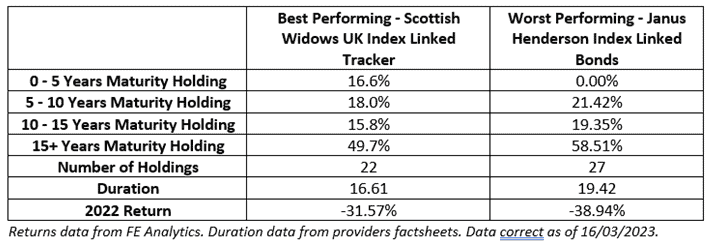
Both funds posted negative returns but the Janus Henderson fund was 7.37% worse off. Both funds have a low number of holdings, showing they are concentrated and restricted in their sector based on what is investable. The Scottish Widows fund has a higher allocation to lower maturity stocks and a lower allocation to higher maturity stocks relative to Janus Henderson.
Duration, which is an indication of a bonds interest rate sensitivity, shows in years how long an investor will have to wait to receive back the capital they invested in the bond in today’s value. The higher the duration the larger the interest rate sensitivity.
The Scottish Widows fund had a lower duration and so was less affected by interest rate rises relative to the Janus Henderson fund.
The above highlights both the restricted offering in the index linked gilt sector and the higher maturity weightings of these funds, which lead to higher durations.
The diversification rules, combined with the higher weighting of longer maturity ILGs and a small number of ILGs in the market, restrict what UK ILG funds can invest in and fence the funds into essentially having to post negative returns when interest rates are rising.
Now if we look at the makeup, performance and characteristics of ILBs from other global regions over 2022, the figures are as follows:
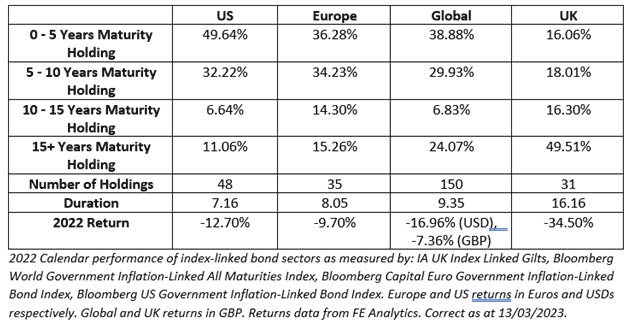
The UK has a much higher maturity base with very few bonds maturing in less than five years. This adds to the much higher duration and is one of the reasons why they performed worse than other regions.
The US Treasury prefers to offer shorter-dated bonds, and while Europe has a similar number of bonds on offer, the weighting to shorter maturities is much greater. The number of holdings is also less than for other regions, meaning that investment managers have a much smaller number of investments to choose from, leading to more concentrated portfolios.
For a UK investor, overseas bonds would have yielded extra return when translated back into pounds sterling, boosting the performance further.
While all bonds have been affected by rising interest rates we can see the extent of the negativity was far greater for UK based government bonds.
Should I hold Conventional or Index-Linked bonds?
The decision whether to hold a conventional bond or a ILB rests on what your inflation expectations are over a given time horizon.
Say you have a 5-year ILB with a real yield of 2% and a 5-year conventional bond with a nominal yield of 5%. The difference between the nominal yield on a conventional bond and the real yield on an ILB is the breakeven inflation rate.
The breakeven inflation rate is the market’s expectation on where inflation will be over the given time horizon. Based on the above example, the markets would expect inflation to average 3% over the 5-year period.
We know what the real return on the ILB is, but the real return on the conventional bond will depend on what the rate of inflation actually is over the next 5-years.
If the rate of inflation over the next five years turns out to be higher than the breakeven inflation rate, then it would have been better to hold the ILB. If inflation was 4%, then the real yield on the conventional bond would be 1%, less than the real yield on the ILB of 2%.
If inflation turns out to be lower than expected over the next five years then it would be better to hold the conventional bond as opposed to the ILB. Say inflation was actually on 1% over the next five years, the real yield on the conventional bond would be 4%, above the ILB yield of 2%.
Real returns are important as opposed to nominal returns. It is what our capital can buy in the future that matters, and in order to keep living to the same or a better standard real returns need to be positive. This is why cash savings accounts, while important for liquidity and short-term goals, over the longer term usually result in depreciation of real capital. Interest rates are lower than in inflation rates for the most part.
While the above example makes the decision look cut and dry, in reality many different factors affect realised inflation and determining whether the market has priced in inflation expectations accurately is difficult. This is far more an art than a science.
Falling Interest rates
We have talked a lot about ILBs being more sensitive to interest rates and much of this article has shown this in a negative view i.e. when interest rates go up bond values go down. However, being more sensitive is also a good characteristic when interest rates are expected to fall. Any newly issued bond will be issued with a lower coupon and yield. Therefore demand for the existing bonds with better coupons increases.
The bond’s price will increase and the yield will fall. This will therefore increase the value. In the scenario where interest rates are falling, bonds with longer maturities, lower coupons and lower yields will gain the most in terms of value.
The ideal scenarios in which to increase allocations to ILBs are during quantitative easing and in a stagflationary environment.
Quantitative easing is when the Central Banks inject money into the market by purchasing government and corporate bonds. This easing of monetary policy is supportive for most assets but especially so for ILBs given their high sensitivity to interest rates and monetary policy. Quantitative easing usually occurs when breakeven inflation rates are below Central Bank’s long-term targets.
A stagflationary environment is where inflation is high but grow is stagnant. In this scenario Central Banks focus on boosting growth by cutting interest rates, which is again supportive of ILBs.
Is the answer to hold short-dated bonds?
If bonds with low interest rate sensitivity provide an element of safety, then why not invest all of the inflation linked allocation to these bonds? The safety that comes with low interest rate sensitivity is not free and not suitable for all occasions!
By that I mean that the overall return from shorter-dated bonds is on average much lower than that for long-dated bonds. When markets are falling and interest rates are rising, shorter-dated bonds do lose less value. But when markets are rising they gain much less.
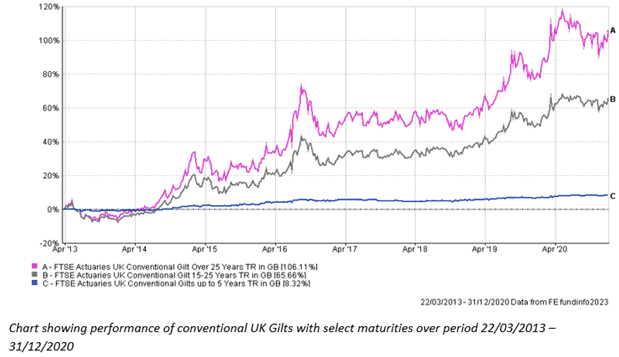
The chart above for the period 22/03/2013 to 31/12/2020 is chosen because over this period, the Bank of England base rate started off at 0.50%, then dropped to 0.25% and ended the period at 0.10%. Interest rates were in very supportive territory and dropped to a historic low of 0.10%. Long dated gilts did very well over this period, with the annualised return being approximately 10.88%. In comparison the shortest-dated gilts annualised returned was just 1.14% over this period.
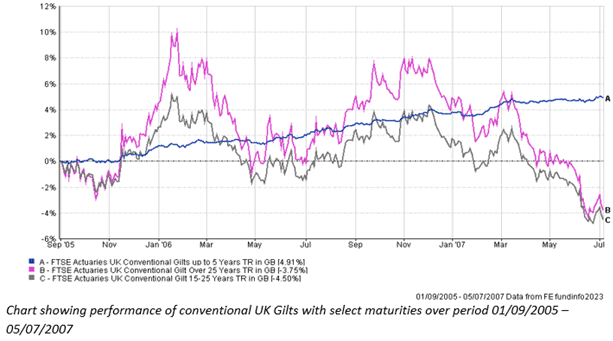
The next chart looks at the period 01/09/2005 to 05/07/2007 when interest rates rose from 4.50% to 5.50%. Over this period we can see the opposite. Long-dated bonds ended the period in negative territory while short-dated bonds moved slowly upwards. Around November 2006 rates increase from 4.75% to 5.00% and longer dated bonds started their decline. This was exacerbated by another 0.25% increase in January 2007. Around February a positive economic report buoyed returns (investors overly optimistic again!) before rates increased again and longer dated bonds dropped further. Despite increasing rates, shorter term bonds still posted positive returns as investor money moved down the maturity spectrum and into these less sensitive bonds.
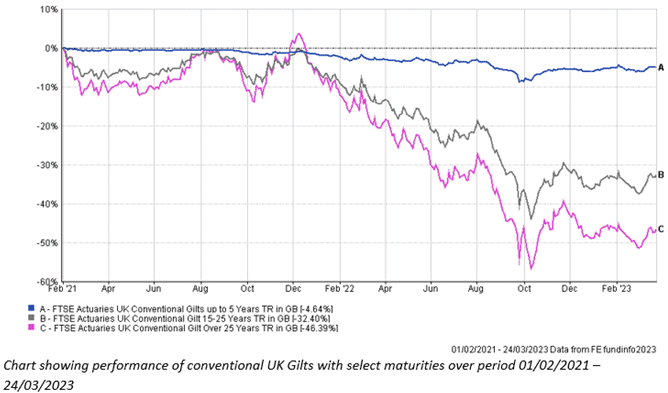
Again, the chart above looks at the last few years and we see that while all bonds dropped in value, shorter-dated bonds held their value to a greater extent. In December 2021 the Bank of England increased the base rate from 0.10% to 0.25% and from here we can see the downturn in bond returns. Between then and the next rate rise in February, short-dated bonds dropped by a few percentage points, while longer dated bonds dropped by 10%.
Bonds have a “term premium” in their value. This means that investors demand a greater return for locking their money away for longer periods of time. There is also more risk over this time that inflation will erode the real values and, although not strictly applicable to government securities, the creditworthiness of the issuer can deteriorate.
Over the past two-years this term-premium has increased and is likely to stay elevated. What this means for longer-dated bonds is that the yield will remain higher than in previous periods as investors demand a greater return for holding and waiting for cashflows from these bonds.
Outlook for Index-linked bonds
Inflation is expected to drop over the next year but will remain at elevated levels, above the Bank of England’s CPI target of 2%. The reasons for this being that higher inflation is now embedded into the economy. Structural problems such as an ageing population mean wages will rise to a greater extent over time, which will feed through to price inflation. The move to decarbonise is also pushing prices up as commodity demand is on the rise.
Interest rates will drop when inflation is under control, or when the Bank of England switches from focusing on inflation to trying to boost economic growth. Recessions are forecast but not with the corresponding easing of monetary policy, yet. Why? Central banks will use the recessions as a way of bringing down sticky inflation.
While markets are pricing in rate cuts this year this is in our view optimistic and is supporting prices at their current levels. Any further interest rate increases that are not yet priced in will have a negative effect on value, but to a lesser extent than previous rates. Bond values have fallen far and any further falls are impacting a smaller base value.
With all that being said ILBs will be useful for portfolios in keeping real values protected in a world of higher inflation, both for income and for holding to maturity.
If not holding to maturity, as many bond funds don’t, then buying in just before interest rates fall will be the ideal point. The key here is knowing when this will be, likely in 2024 or possibly the end of 2023 if markets are correct.
When rates do fall longer-maturity bonds will outperform shorter maturities due to their increased sensitivity. With higher “sticky” inflation, ILBs will still be preferential over conventional bonds as markets currently believe inflation will be lower than it likely will be. This means the actual inflation rate will be higher than the breakeven inflation rate.
In the shorter-term short maturities are still preferred for income as the market environment is very volatile with continued uncertainty.
Robert Dougherty, Associate IFA
April 2023
This article is not a recommendation to invest and should not be construed as advice. The value of an
investment can go down as well as up, and you may get less back than you invested.